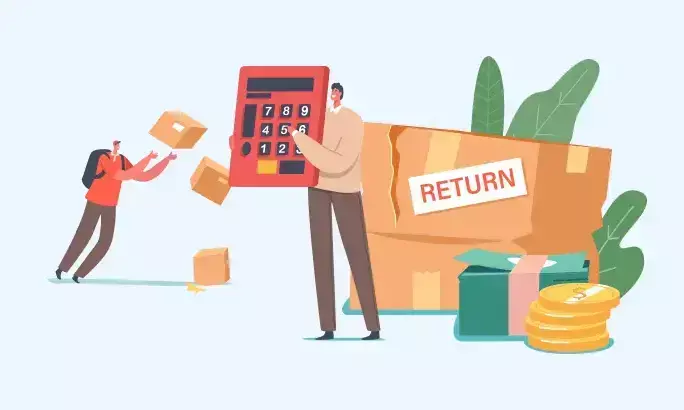Return-to-profits playbook: Art of monetizing on returns

Thanks to the government’s Digital India initiative, India is set to claim the title of the second-largest Internet market trailing China and ahead of the United States. Close to 30% of 1.4 billion Indians, i.e. about 420 million, will soon have successfully transitioned into the realm of digital shopping.
When questioned on the topic of returns in 2023, 50% of 5000 Indian respondents aged 18-54 said they returned apparel purchased online. Close to 20% of survey participants confessed to returning products belonging to the categories of consumer electronics, household appliances, and furniture. Even pet products claimed a surprising 12% share in the most returned winner list.
It doesn’t seem so bad, does it? But when you break it down - that’s 5 out of 10 t-shirts, 1 out of 5 ovens, and 2 out of 15 kibble bags that made their way back to the store in 2023. These pared-down numbers become spine-chilling when you key in the forecasted online shopping market of India, estimated to hit 350 billion US dollars by 2030.
Understanding the potential of returns
A layman’s plain-speak for returns would be an unsuitable purchase. Sometimes shoppers might assume things based on their purchase history, and sometimes it is the brand that’s at fault for not listing out the details accurately. This is assuming the shopper is the primary recipient. The deceptive landscape of gifting too, has led many a customer astray.
And with the growth of digital shopping in India, the horrific tale of burgeoning returns, quite obviously, is not too far behind. Returns bring with them the woes of cut-rate or even unsaleable inventory, the burden of reverse logistics costs, and the imprint of a disappointing purchase experience in the psyche of the shopper.
We’ve come a long way from the drudgery of manually processing returns and refunds. Now everything from a customer’s return request to booking the right carrier can be automated via logistics software. But every return comes at a staggering cost. It is vital to develop a strategic mindset - to understand the limitless possibilities of returns and view them as an opportunity rather than a debilitating setback.
Strategies for monetizing returns
Most brands fail to see a return request for what it is - a way to strengthen the bond between a customer and a business.
In the not-so-distant past, there were three key ways to monetize on returns and keep customers happy - the leveraging of repackaged returned products for resale, creating customer loyalty programs to improve retention, and liquidating stock in grey markets by collaborating with third-party service providers. We’re light years ahead of these strategies today.
Now it’s all about building and nurturing strong brand-shopper relationships. With a few simple tweaks, brands can stay on top of their returns, and even monetize off of them. Through personalization and smart communication, it can be quite straightforward to retain the interest of the shopper and perhaps even guide them towards a more appropriate choice of product.
The Switch
When a shopper is processing a request for a return, take this opportunity to gently nudge them towards an exchange instead. Quite honestly, with the number of options out there, a large number of customers hit the Buy Now button only if they are sure about their choice.
According to a survey of American consumers, 35% of Gen X and 27% of Boomers chose to return their product because it did not fit as expected. This is easy enough to fix. Given the chance and quick exchanges, your shoppers can be persuaded to switch their sizes, helping you retain the revenue.
The Alternate
Similar to the switch, this move addresses the concerns of the 18-25% who do not think the product they purchased lives up to its promise in terms of quality and aesthetics. In this instance, brands must curate personalized recommendations and motivate shoppers to proceed with a product exchange instead.
A mix of product suggestions based on the shopper’s purchase history, and top-rated products from the brand’s inventory could potentially do the trick and engage the shopper’s attention. By encouraging shoppers to opt for a product exchange instead, you gain in customer retention.
The Persuasion
According to a 2023 study, 40% of prepaid orders and more than 60% of COD orders are processed for returns. While more brands continue to offer COD payment options to their shoppers to encourage buying, the lack of financial commitment encourages customers who may lack genuine intent to purchase.
Common reasons for COD order returns are these - financially dependent shoppers purchase goods from a family member’s phone without their approval, repeat return offenders who are not serious about their purchase but ride the endorphin wave of online shopping, or those who were not prepared for the offline payment mode.
To avoid these situations, it makes sense to persuade shoppers to opt for prepaid mode once the order manifestation is complete. This can be done with offers of discounts or loyalty rewards. By encouraging prepayment, brands can successfully cut down returns stemming from COD.
Key takeaway
The most critical aspect to any business’s financial standing and brand reputation regardless of whether their operations are digital or brick-and-mortar, is how they manage their returns. It is a good idea to invest in fostering faith in the brand promise and retaining existing customers as opposed to experiencing high churn and acquisition costs.
We’ve outlined the strategy for the switch, the alternate, and the persuasion methods to monetize on returns. What it all boils down to is that plain communication of intent to clean up the mess and ensure the shopper’s purchase experience has not been marred can really work wonders in nurturing the buyer-seller bond.
The views and opinions expressed in this article are those of the author and do not necessarily reflect the views of Indian Transport & Logistics News.




